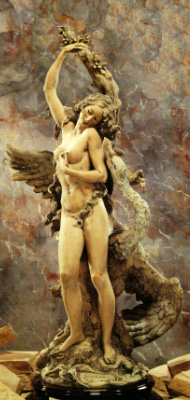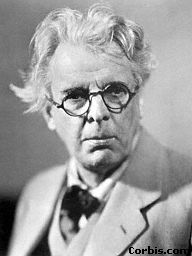![]()
![]()
![]()
|
Palazzo Milzetti |
|
I Miti |
|
Leda
| LEDA
IN THE "BOUDOIR" The boudoir, the room of Count Milzetti ‘s young wife, is decorated over all its walls and ceiling. Very slender structures in trompe d’oeil way are painted on the walls, and there are also five paintings under glass, which represent five episodes about the Gods’ loves : Leda and the Swan, Diana and Endimione, abduction of Europe, Phoebus and Daphne, abduction of Proserpina. The first, in particular, is represented in this way : in the foreground, on the left, there is Eros in a white cloak. In the background there is Leda with the Swan surrounded by some Cupids. The landscape is mountainous and, in the distance, you can glimpse a village. The predominant colours are : light blue, green, black, blue and white. On the ceiling, in the center, there is the "Trionfo di Amore" (Triumph of Eros), from Petrarca and it is surrounded by paintings, which represent the Fire, the Water, the Air and the Earth. In the circles there are the allegories of the four seasons. In the four corners of the room there are four mirrors used as doors, behind which there are some shelves.
|
|
| THE
MYTH OF LEDA AND THE SWAN Leda, daughter of Testio, had several
children from Tindaro: Timandra, who married Echemo, Clitennestra,
Agamennone’s wife, Helena and the Dioscuri.
|

|
| LEDA AND THE SWAN by W.B.YEATS
"Leda and the swan" is a sonnet even if unusual in its layout. It can be considered as an Elisabethan sonnet as its 14 verses are divided in quatrains and tercets, even if they are not traditionally divided because the last 6 verses can be considered as tercets sharing half line of the eleventh with the twelfth which implies also an interruption in rhythm and meaning. The rhyme pattern is regular ABAB CDCD FGH FGH. The length of the lines is regular as well. The first and the second part convey the brutality of the event by the use of the alliteration in "b" and of monosyllabic and bisyllabic words. The poet evokes the idea of violence by using adjectives, nouns and verbs expressing power and the claim of omnipotence with reference to Zeus ("great wings" ; "feathered glory" ; "white rush" ; "brute blood of the air"; "hold" ; "power" ; "indifferent" ). The fragility, the weakness and fear of Leda are conveyed by the use of alliteration in "h" and of words like : "staggering girl"; "helpless"; "terrified vague"; "mastered" .The third part is instead a remind of the fate of Troy which can be connected to Leda’s suffered injustice. Helena and Clitemnestra will be generated by Leda and they will be the cause of the destruction of Troy and Agamennon’s death. |
 William Butler Yeats |
|
Palazzo Milzetti |
|
Inizio pagina |
|